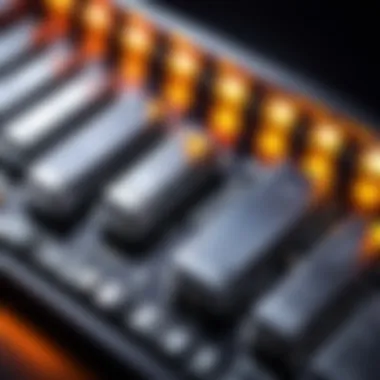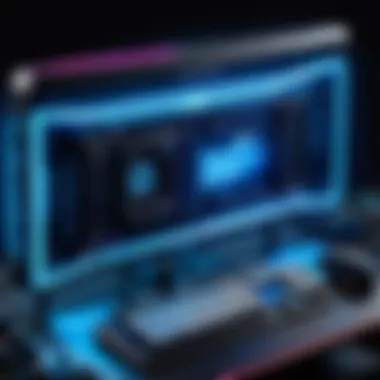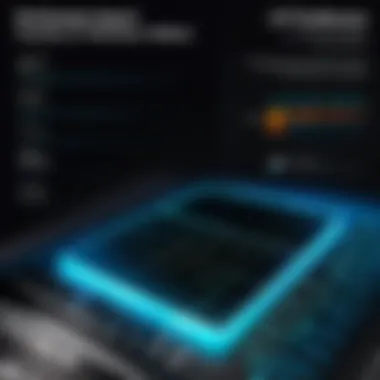Exploring LED RAM: Insights into Technology and Aesthetics


Intro
The integration of LED technology into RAM modules has become a notable trend in the tech industry. This relationship goes beyond mere aesthetics; it encapsulates performance enhancement, user experience, and market trends. As enthusiasts and casual consumers alike explore new hardware, understanding LED RAM’s implications, benefits, and limitations is essential. This article will guide readers through various facets of LED RAM, providing a comprehensive viewpoint on how these elements interact within modern computing environments.
Product Overview
Key Features
LED RAM, often equipped with dynamic RGB lighting, adds a flair to any computer setup. Among its striking features:
- Adjustable Lighting Effects: Users can customize colors and patterns.
- Heat Dissipation: Some models are designed to aid with thermal management, enhancing overall performance.
- Sync Capabilities: Compatibility with motherboard software allows for synchronized lighting across components.
Technical Specifications
The technical details behind LED RAM often vary across manufacturers, but essential specifications include:
- Memory Type: DDR4 or DDR5, depending on the model.
- Capacity: Options range from 8GB to 64GB or more.
- Speed: Ranges from 2400 MHz to 3600 MHz and higher.
- Voltage Requirements: Typically around 1.2V for DDR4.
Pricing Information
Price points for LED RAM can differ significantly.
- Average cost per module varies from $70 to $300 depending on brand, capacity, and speed.
- More specialized models may even surpass this range. This typical pricing structure positions LED RAM in a competitive market while attracting both gamers and PC builders.
Performance Analysis
Benchmark Results
Benchmark tests show that while LED lighting does not directly influence performance, some models feature improved cooling designs that may translate into better thermal performance and stability. In synthetic benchmarks like Cinebench, RAM with enhanced thermal management can yield higher performance scores under load.
Real-World Use Cases
LED RAM is popular among gamers and content creators. In gaming, the enhanced appearance contributes to a more immersive setup. For tasks like video editing, its high capacities and speeds improve multitasking efficiency.
Comparison with Competitors
When compared to non-LED RAM counterparts, the primary difference lies in aesthetics and the potential for slightly better cooling. Brands like Corsair, G.Skill, and Kingston offer LED RAM options that perform comparably to their non-LED products, but the eye-catching design provides an edge in appeal.
Installation and Setup
Required Tools and Components
For successful installation of LED RAM:
- A compatible motherboard with available DIMM slots
- Basic tools like a screwdriver (if needed)
Step-by-Step Installation Guide
- Power down the computer and unplug it.
- Open the computer case.
- Locate the RAM slots on the motherboard.
- Align the RAM module with the slot and press down firmly until it clicks.
- Close the case and power on the computer.


Troubleshooting Common Issues
- If the RAM is not recognized, ensure it is seated properly.
- Check BIOS settings to ensure correct timing and speed settings are applied.
Pros and Cons
Advantages of the Product
- Aesthetic Appeal: LED RAM adds visual enhancement to any setup.
- Potential for Better Cooling: Some models help manage thermal issues more effectively.
Disadvantages or Limitations
- Cost: Generally, LED RAM is more expensive than standard RAM.
- Marginal Performance Benefits: Majority of users may not notice significant differences in performance.
Who It’s Best Suited For
LED RAM is ideal for gamers and users who appreciate an aesthetically pleasing build. It may also appeal to those building high-performance computers, where every detail matters.
Final Thoughts
Summary of Key Points
Embracing LED technology in RAM modules introduces both visual and practical benefits, although the actual performance differences may be minimal for general use.
Recommendations for Potential Buyers
When considering whether to invest in LED RAM, weigh aesthetics against the potential additional cost and slight performance enhancement. Brands like Corsair and G.Skill offer reliable options with good warranties.
Future of the Technology or Product Line
The future may see further advancements in LED RAM, perhaps with more sophisticated lighting effects or integrated monitoring features. As consumers continue to prioritize aesthetics alongside performance, LED RAM will likely remain a relevant choice.
Understanding RAM Technology
Understanding RAM technology is crucial for appreciating its role in computer systems and how it relates to innovations like LED RAM. Random Access Memory is a key component that determines system performance and user experience. In the age where speed and responsiveness are paramount, familiarity with RAM technology aids consumers and tech enthusiasts in making informed decisions about their hardware.
Definition and Function of RAM
RAM, or Random Access Memory, is a type of volatile memory used in computers and devices to store data temporarily. This enables quick access and manipulation of data by the processor. When a computer runs applications, it uses RAM to hold data that is actively being processed. This functionality is essential because it allows for multitasking and efficient operation of software. Without sufficient RAM, systems can become sluggish, leading to decreased productivity.
Types of RAM: An Overview
There are several types of RAM, each serving different purposes in computing environments. Popular types include:
- DRAM (Dynamic RAM) - commonly used in desktops and notebooks, storing data in capacitors that need regular refreshing.
- SRAM (Static RAM) - faster and more expensive than DRAM, utilized in cache memory within processors.
- DDR (Double Data Rate) - a type of DRAM that transfers data on both the rising and falling edges of the clock cycle, improving performance. Variants like DDR3, DDR4, and DDR5 have evolved, offering increased speed and efficiency.
Understanding these variations helps in grasping how RAM influences the overall system performance and in selecting the right memory for specific tasks.
The Evolution of RAM Technology


The evolution of RAM technology mirrors the rapid advancements in computing. From the early magnetic-core memory to today’s high-capacity DDR5 modules, RAM has undergone significant changes. Initially, RAM was bulky and slow, limiting computing tasks. However, innovations in integrated circuits and materials have led to smaller, faster, and more energy-efficient memory types.
Some milestones in RAM evolution include:
- Introduction of MOSFET technology, significantly improving switching speed.
- The development of multi-channel memory architectures, enhancing data transfer rates.
- Recent advancements focus on energy efficiency and data integrity, paving the way for future energy-conscious devices.
The significance of understanding RAM technology lies in recognizing how these advancements affect performance metrics, influence design choices, and align with modern computing needs.
Prelims to LED Technology
LED technology plays a pivotal role in modern computing, particularly as it merges with innovative hardware designs such as RAM. Understanding LED technology is crucial for appreciating its implications on performance, aesthetics, and overall user experience. LEDs, or light-emitting diodes, have transformed the way devices operate and appear, enhancing not just functionality but also the visual appeal that appeals to tech enthusiasts and casual users alike. This section sheds light on the essential aspects of LED technology, which will become increasingly relevant as we delve into its integration with RAM.
What is LED?
LED, or light-emitting diode, is a semiconductor device that emits light when an electric current passes through it. Unlike traditional incandescent bulbs, LEDs are efficient and compact, making them ideal for variety of applications. They operate using a principle called electroluminescence, where electrical energy is converted into light. This conversion process enables LEDs to produce bright light while consuming less power, which is beneficial for both device performance and energy conservation.
The Science Behind LEDs
The function of an LED hinges on the properties of semiconductor materials. When electrons recombine with holes within the material, energy is released in the form of photons, resulting in light emission. The color of the emitted light depends on the energy band gap of the semiconductor material used. Popular materials include gallium arsenide and gallium nitride, which can generate a range of colors from red to blue. Furthermore, heat management is crucial, as overheating can affect both the brightness and lifespan of an LED, making heat sinks and thermal management essential in design considerations.
Common Applications of LED Technology
LED technology has infiltrated numerous fields beyond just lighting. Key applications include:
- Display technology: Used in televisions, computer monitors, and smartphone screens for vibrant displays.
- Automotive lighting: Increasingly employed in car headlights and taillights for better visibility and safety.
- Indicators and signs: Commonly utilized in traffic signals, digital billboards, and various indicators due to their visibility.
- Backlighting: Incorporated within devices for keypads, screens, and other interfaces to enhance user interaction.
- Decorative lighting: Employed in aesthetics for ambient lighting in homes and events.
LED technology continues to evolve, offering improved efficiency and options that cater not just to practicality but also to consumer preferences. As we explore the intersection of LED and RAM technology, these insights into LED's function and application will prove indispensable.
The Intersection of LED and RAM
The integration of LED technology within RAM modules is not merely a trend but an essential evolution in computer hardware. Understanding the intersection of LED and RAM provides vital insights into both aesthetics and functionality. The relevance of this intersection lies in several key aspects: lighting as a design feature, enhanced user experience, and the potential performance implications.
What is LED RAM?
LED RAM refers to random access memory modules that incorporate light-emitting diode (LED) technology into their design. This innovation often manifests as customizable lighting patterns or colors, allowing users to modify the appearance of their computer systems. By integrating LEDs, manufacturers aim to enhance the overall aesthetic appeal of the hardware while simultaneously ensuring it performs its core functions effectively. This combination of visual flair and technical capability caters to the needs of gamers and tech enthusiasts who value personalization and performance alike.
Benefits of LED RAM
LED RAM offers several advantages that appeal to different segments of the computing community:
- Aesthetic Customization: One of the most pointed benefits is the visual customization that LED RAM affords. Users can often control the colors and lighting effects, aligning their hardware with personal style or matching gaming setups.
- Visual Feedback: Some RAM modules use LED lighting to indicate performance metrics. This can facilitate troubleshooting by signaling conditions like overheating.
- Enhanced Marketability: Manufacturers of LED RAM benefit from heightened interest and perceived value, catering specifically to the gaming and tech enthusiast markets.
- Improved Cooling: In some designs, LEDs can contribute to enhanced heat dissipation, although this is often a secondary benefit compared to their aesthetic role.
These benefits make LED RAM an appealing option for those seeking both functionality and visual enhancement in their systems.
Drawbacks of LED RAM
Despite its benefits, LED RAM is not without its drawbacks:
- Cost: LED RAM tends to be more expensive than traditional RAM options. This premium might deter budget-conscious consumers who prioritize performance over aesthetics.
- Power Consumption: Incorporated LEDs consume additional power. While this is typically minimal, it may be a consideration for users focused on energy efficiency.
- Limited Performance Impact: For many tasks, the presence of LEDs does not directly influence the performance of RAM. Users looking for substantially better performance may find that the investment in LED features does not yield significant functional improvements.


Aesthetics vs.
Performance
The integration of aesthetics and performance is a vital aspect when analyzing LED RAM. As consumers continue to seek cutting-edge technology, the visual appeal of hardware cannot be dismissed. Enthusiasts often look for components that not only perform well but also enhance the overall aesthetic of their builds. The shimmering illumination provided by LED technology offers both a cosmetic upgrade and a potential indicator of advanced engineering.
However, the focus on aesthetics raises questions about performance. Does the inclusion of LED lighting affect the operational efficiency of RAM modules? This inquiry demands careful consideration, influencing purchasing decisions and consumer preferences.
The Role of Aesthetics in Computer Hardware
Aesthetics play a significant role in the hardware marketplace. Custom PC builds are now a passion for many users, particularly gamers and tech enthusiasts. The appearance of RAM, often placed prominently within a case, can influence the visual theme of the entire system.
- Visual Appeal: Bright LEDs create a vibrant and engaging atmosphere, contributing to the overall design of the setup.
- Customization: Many manufacturers offer RGB lighting solutions, allowing users to synchronize lighting effects across components.
- Market Differentiation: Brands utilize aesthetic features to stand out in a competitive landscape.
In essence, aesthetics in computer hardware is not merely about looks; it reflects the user's identity and preferences. With products like Corsair Vengeance RGB Pro and G.Skill Trident Z RGB being prominent examples, the market caters to those who prefer a unique style.
Does LED Affect Performance Metrics?
The intersection of LED technology and RAM performance is complex. When assessing whether LED illumination impacts performance, several factors must be examined.
- Power Consumption: LEDs draw a minuscule amount of power, which is unlikely to affect RAM performance significantly.
- Thermal Management: Excessive heat can degrade RAM functionality, but well-designed LED RAM typically incorporates adequate cooling solutions.
- Latency and Speed: Current research suggests that there is no direct correlation between LED lighting and latency or speed of RAM.
Ultimately, while aesthetics enhance the visual appeal of RAM modules, it appears that they do not detract from core performance metrics. This finding may reassure consumers who consider aesthetics but are concerned about maintaining system efficiency.
"The balance between style and functionality is crucial for modern tech consumers, impacting their buying choices and satisfaction."
Market Trends and Consumer Preferences
Understanding market trends and consumer preferences is crucial in evaluating the impact of LED RAM on the tech industry. With the rise of visually appealing hardware components, consumer demand has evolved, influencing manufacturers to respond with innovative designs and functionalities. In the context of LED RAM, this means assessing not just performance metrics but also how aesthetic enhancements interact with user experience.
Current Trends in LED RAM
The current landscape for LED RAM is defined by growing adoption and visibility in the gaming and high-performance computing sectors. As gamers and tech enthusiasts seek personalized setups, LED RAM modules have gained traction for their striking visual appeal. Popular products like Corsair Vengeance LPX and G.Skill Trident Z Neo capitalize on this. These RAM modules feature customizable lighting effects, aligning perfectly with the trend of RGB lighting in computer builds.
Manufacturers are also focusing on heat dissipation technology, incorporating LEDs into designs that do not compromise efficiency. This consideration helps direct attention to the modules while preserving their operational integrity.
Additionally, there's an increasing trend towards compatibility with software platforms, such as Asus Aura Sync and MSI Mystic Light, allowing for synchronized lighting effects across multiple components. While aesthetics drive demand, technical innovation continues to keep pace.
Consumer Responses to LED RAM Products
Consumer reception to LED RAM products reflects a mixed yet enthusiastic narrative. Many users appreciate the visual benefits, which enhance not only the look of their systems but also personal expression. However, there remains a contingent of buyers who prioritize function over form and question the necessity of added features.
When trying to balance aesthetics with performance, reviews often highlight these points:
- Visual Appeal: Many users enjoy enhancements that contribute to a cohesive look of their builds. This aspect has grown into a significant factor when selecting RAM.
- Performance Considerations: While RGB lighting often adds a price premium, discerning consumers analyze performance metrics carefully, looking for balance.
- Price Sensitivity: As consumers explore LED RAM options, price sensitivity becomes evident. Certain buyers revert to standard RAM modules if they believe the performance payoff does not match higher costs.
The Future of LED RAM
As technology progresses, the intersection of LED technology and RAM defines an intriguing horizon for both consumers and manufacturers. The integration of LEDs into RAM modules is not just a novelty for aesthetics; it reflects the advancements in thermal management, performance, and user experience. This section explores the significance of LED RAM’s future and its implications in the computing landscape.
Innovative Developments on the Horizon
The advancements in LED RAM technology are noteworthy. Many companies are currently investing in research and development to refine how LEDs interact with memory modules. For instance, some manufacturers are exploring ways to enhance the functionality of LEDs beyond mere illumination. This includes:
- Dynamic Lighting: LEDs can be programmed to indicate system status or alerts. This can provide real-time feedback about system performance or errors.
- Thermal Management: LEDs can help with heat dissipation. By incorporating smart lighting solutions, manufacturers may reduce overheating risks, thereby extending the lifespan of the RAM.
- Gaming Integration: Gamers often seek a visually cohesive setup. Enhanced color patterns that sync with in-game actions or music can offer a more immersive experience.



